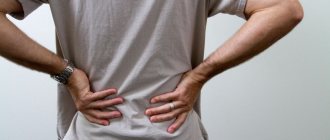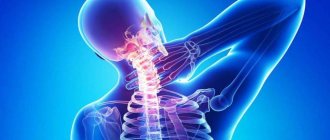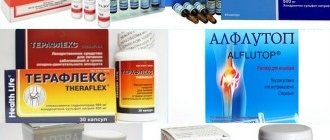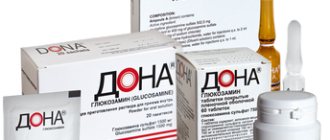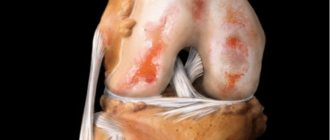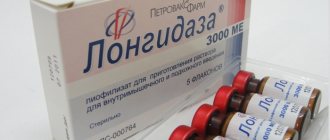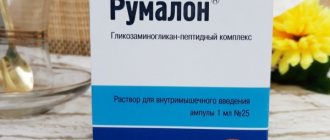Release form and composition
Don is produced in the following dosage forms:
- Film-coated tablets: white, oblong; on the cross section there are two layers: the outer one is white, the inner one is white with a brownish tint (in polyethylene bottles of 60 or 180 pcs., 1 bottle in a cardboard box);
- Powder for preparing a solution for oral administration (in sachets of 1500 mg, 20 or 30 sachets in a cardboard box);
- Solution for intramuscular administration (in dark glass ampoules of 2 ml, 6 ampoules in a cardboard box complete with solvent).
1 tablet contains:
- Active substance: glucosamine – 750 mg (in the form of sulfate);
- Auxiliary components: macrogol 6000, microcrystalline cellulose, povidone K25, magnesium stearate, croscarmellose sodium, talc.
Film shell composition: copolymer (1:1) of methyl methacrylate and methacrylic acid (Eudragit L 12.5), crushed titanium dioxide, talc, triacetin, copolymer (2:1:0.2) of methyl methacrylate, ethyl acrylate and trimethylammonioethyl methacrylate chloride (Eudragit RL 30 D), macrogol 6000.
The composition of 1 sachet of powder for the preparation of a solution for oral administration includes:
- Active substance: glucosamine – 1500 mg (in the form of sulfate);
- Auxiliary components: citric acid, sodium chloride, sorbitol, aspartame, carbowax 4000.
The composition of 1 ml of solution for intramuscular administration includes:
- Active substance: glucosamine – 200 mg (in the form of sulfate);
- Auxiliary components: sodium chloride, lidocaine hydrochloride, water for injection.
Solvent: diethanolamine, water for injection.
"DONA": analogues are cheaper
Similar means are used when a person has an allergic reaction or side effects to an original medical product. The use of the original is completely prohibited; if you have symptoms, consult a doctor, he will prescribe worthy analogues:
Glucosamine . The most popular remedy replacing Don. It is produced in Russia and is completely identical to the original drug. The medicine is based on glucosamine, which is why it is called that. Performs the function of normalizing metabolism in cartilage tissues, has a good effect on suppressing pain. Available in powder form. Price in pharmacies up to 810 rubles;
Tazan . The company producing this medication is located in Russia. A good remedy for the treatment of osteoarthritis, and it is used for various types of this disease. Glucosamine and sodium chondroitin sulfate play a key role in the composition. The release form of the pharmaceutical product is tablets. The cost in stores varies from 800 to 1300 rubles;
Elbona . Substitute of Russian origin. The analogue has the same composition and contains the same components as Dona. The main functions of Elbon are the elimination of pain and inflammation. Has good regenerative ability. Indicated for osteoarthritis of varying degrees. It is produced in the form of a sachet or solution. Price category - from 1000 to 1300 rubles;
Artradol . Country of origin: Russia. Prescribed for diseases associated with arthrosis, osteoarthrosis, intervertebral osteochondrosis. The active ingredients are lyophilisate and sodium chondroitin sulfate. Available as an injection. The cost of this product in a pharmaceutical boutique reaches 900 rubles.
Contraindications
- Age up to 12 years;
- Pregnancy and lactation;
- Hypersensitivity to the components of the drug.
Don should be used with caution in patients with allergies to seafood (shellfish, shrimp).
Additionally, the drug is contraindicated for use in the following diseases:
- Tablets: severe chronic renal failure;
- Solution for intravenous injection: acute heart failure, cardiac conduction disorders, severe functional disorders of the kidneys and liver, history of epileptiform seizures.
Dona in the form of an injection solution should be used with caution in patients with arterial hypotension and chronic heart failure.
Indications for use:
- The use of the medication is relevant for osteoarthritis of the joints , this is a disease of the joints associated with their degenerative and dystrophic properties. The main cause of osteoarthritis is deformation of the cartilage tissue located on the surfaces of the joints. You can find out about the occurrence of osteoarthritis by the signs - pain after a long stay in one position, sitting, lying down, swelling of the joints, sounds that are not characteristic of bones, crunching, unpleasant sensations of friction of bone joints;
- The medicine is prescribed to people who have arthritis . The concept of this disease is very broad; arthritis comes in different forms. In general terms, this is inflammation of the joints. Arthritis acts as a key disease or can become a disease against the background of another problem in the human body. Symptoms of arthritis are a feeling of stiffness in movements, swelling, increased body temperature in certain places, deformation of the limbs;
- The medical product is used for Arthrosis , a disease during which cartilage is destroyed. Signs of the disease appear gradually and may not be noticeable in the early stages. Slight pain during any heavy load, crunching when moving, poor mobility become the first signs of arthrosis.
Contraindications
Dona, like any other pharmaceutical product, has its contraindications. If the drug is used incorrectly, problems arise, especially for people with allergies who have not read the ingredients. If you have a personal intolerance to any of the chemicals in the product, you should avoid it. There is no need to use the drug for diseases associated with the excretory system. Also, refuse the medication if you have unstable functioning of the cardiovascular system.
Side effects
If you experience other symptoms that are not similar to allergies after taking Dona, you should consult a doctor. Side effects of this drug are extremely rare. These include headache or dizziness, most often this is associated with heart disease or blood pressure; this item is described in contraindications. If you are allergic to fish products, from which some of the ingredients of the medicine are made, itching, rashes on the skin, and redness occur. Possible manifestations include dry mouth, nausea, and malaise.
Directions for use and dosage
The regimen and duration of treatment is determined by the doctor.
Dona in tablet form is taken orally with a glass of water, preferably with meals.
Usually prescribed 2 times a day, 1 tablet (750 mg) or 1 time a day, 1 sachet (1500 mg). The symptomatic effect occurs 14-21 days after the start of therapy. The minimum duration of the treatment course is 4-6 weeks. If necessary, the course can be repeated at intervals of 2 months.
Dona in the form of an injection solution is administered only intramuscularly (the drug is not intended for intravenous administration). Before use, the drug solution should be mixed in one syringe with a solvent. The resulting volume (3 ml) is administered intramuscularly (frequency rate – 3 times a week). Duration of therapy is 4-6 weeks. Injections can be combined with taking Dona orally.
Indications for use of the drug Dona
The medicine is prescribed for the treatment of many diseases not only of the joints, but also of the spine. The drug acts not only as a chondroprotector, but also as a non-steroidal anti-inflammatory drug.
These data have been confirmed and provide grounds for prescribing medicine for the treatment of the following diseases:
- osteoarthritis of various localizations (knee, hip, ankle, elbow, wrist and other joints);
- arthritis and polyarthritis;
- arthrosis and polyarthrosis;
- shoulder osteochondrosis;
- coxarthrosis;
- spondylosis;
- osteochondrosis and chondrosis of the spine (thoracic, cervical, lumbar);
- spondylitis;
- glenohumeral periarthritis.
Side effects
As a rule, Dona is well tolerated.
In some cases, flatulence, gastralgia, diarrhea, nausea, constipation, drowsiness, headache, allergic reactions (in the form of erythema, urticaria and itching) may develop during therapy.
When using Dona in the form of an injection solution, due to the lidocaine included in its composition, the development of nausea, vomiting, drowsiness, diplopia, dizziness, headache, numbness of the mucous membrane of the mouth and tongue, tremor, disorientation, euphoria, and cardiac conduction disorders is possible.
Brief conclusions
Pharmaceuticals have made great progress by developing the drug Dona and its analogues containing glucosamine for the restoration of cartilage tissue in joints.
Not a single non-steroidal anti-inflammatory drug is capable of restoring damaged cartilage tissue, while Dona has such “powers”. This is not just a chondroprotector - it is a medicine that combines the effects of several groups of drugs at once:
- Non-steroidal anti-inflammatory drugs.
- Chondroprotectors.
- Painkillers.
- Anabolic drugs.
Unlike many other drugs prescribed for the treatment of diseases of the musculoskeletal system, Dona has a small list of contraindications and side effects. If an adverse reaction to the drug occurs, it is very rare. Contraindications to the use of Dona for the treatment of joints are childhood, pregnancy, lactation, renal and heart failure, allergic reactions.
The medicine is convenient because it is available in several forms (powder, capsules and injections), which makes it convenient to take.
Each dosage form has its own characteristics and its own speed of action; the first effect of the injections appears the fastest (within 3-4 days); the powder acts the slowest. The dosage of the active substance in each dosage form also differs, therefore the drug, its dosage form and dosage for treatment should be prescribed only by a doctor.
Drug interactions
Don can be used simultaneously with non-steroidal anti-inflammatory drugs, glucocorticosteroids and paracetamol. The drug reduces the absorption of chloramphenicol and semisynthetic penicillins, increases the absorption of tetracyclines, and also enhances the effect of coumarin anticoagulants.
Caution must be exercised when prescribing Dona injections simultaneously with digitoxin, beta-blockers, amnodarone, ajmaline, verapamil, procainamide, quinidine, thiopental or sodium hexenal, monoamine oxidase inhibitors, cimetidine, polymyxin-B, sedatives or hypnotics.
